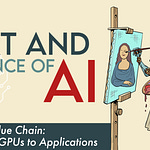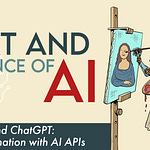In this episode, we dive into the fundamentals of AI, starting with its basic definition and exploring how it has evolved over time. We discuss the differences between two approaches to AI — rule based systems and machine learning — using examples such as classification for spam filtering and linear regression for house price prediction. We dive deeper into classical machine learning, introducing the concepts of model architecture, features, parameters, objective functions, and training algorithms. We conclude by considering some of the limitations of classical machine learning, and the rise of neural networks.
🎧 Listen to the episode
Watch or listen to the episode on YouTube, Spotify, Apple Podcasts, Substack (right on top of this page), or copy the RSS link into your favorite podcast player!
⏰ Chapters
00:00: Preview and intro
01:08: Evolution of AI from rule-based systems to machine learning
02:45: Two approaches to AI: Rule-Based Systems vs. Machine Learning
11:25: Machine learning concepts: model architecture, features, and parameters
20:30: Machine learning concepts: objective function and model training
🧠 Key concepts
The definition of AI is a moving target which evolves over time
There are two broad approaches to AI: rule-based systems and machine learning
In rule-based systems we handcraft the rules, whereas in machine-learning the program automatically learns rules from the data
The core concepts in machine learning are: model architecture, features, parameters, objective functions, and training algorithms
Classical machine learning excels at classification and regression tasks
🔗 References
Art and Science of AI: ArtScienceAI.substack.com
Nikhil Maddirala: https://www.linkedin.com/in/nikhilmaddirala/
Piyush Agarwal: https://www.linkedin.com/in/piyush5/
📓 Detailed notes
Definition and evolution of AI: AI refers to computer systems performing tasks that typically require human intelligence. The definition of AI is a moving target which evolves as computers get better over time.
Rule-based systems vs. machine learning: Rule-based systems rely on predefined rules, while machine learning models discover rules from data, leading to more powerful AI systems.
Machine Learning Concepts: Key components of machine learning models include model architecture, features, parameters, objective functions, and training algorithms. Understanding these basic concepts is crucial for grasping how AI systems make predictions.
Examples of Machine Learning: Classical machine learning techniques are still widely used in various applications, from spam filtering to prediction and personalization. Linear regression is a simple example of a machine learning model.
Classical ML vs. neural networks and deep learning: Classical machine learning includes regression and classification tasks, which are widely used in business applications. Modern approaches, such as neural networks and deep learning, have gained prominence due to increased computational power and data availability.
💬 Keywords
#AI #ArtificialIntelligence #GenerativeAI #GenAI #LLM #MachineLearning #ML #tech











